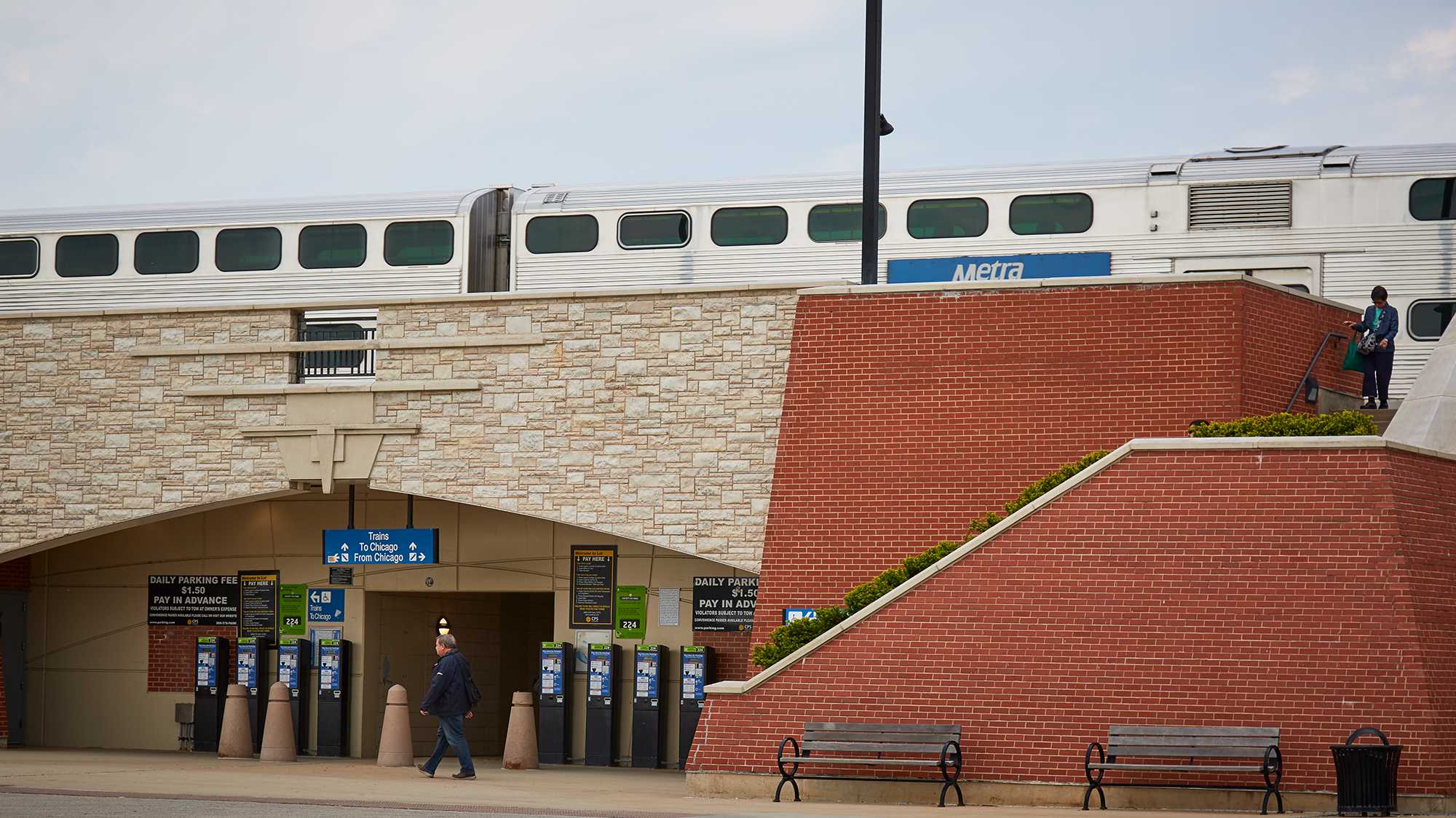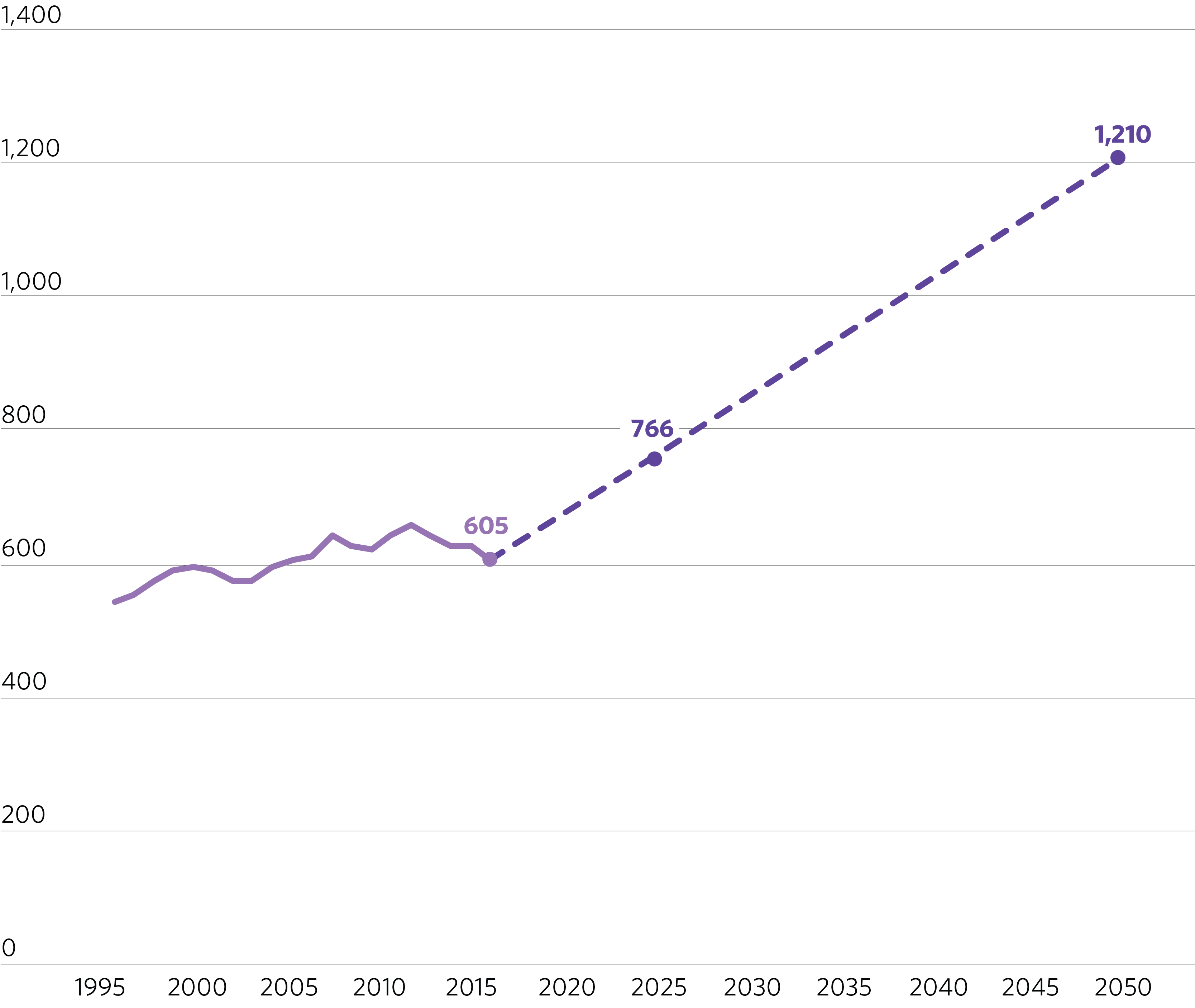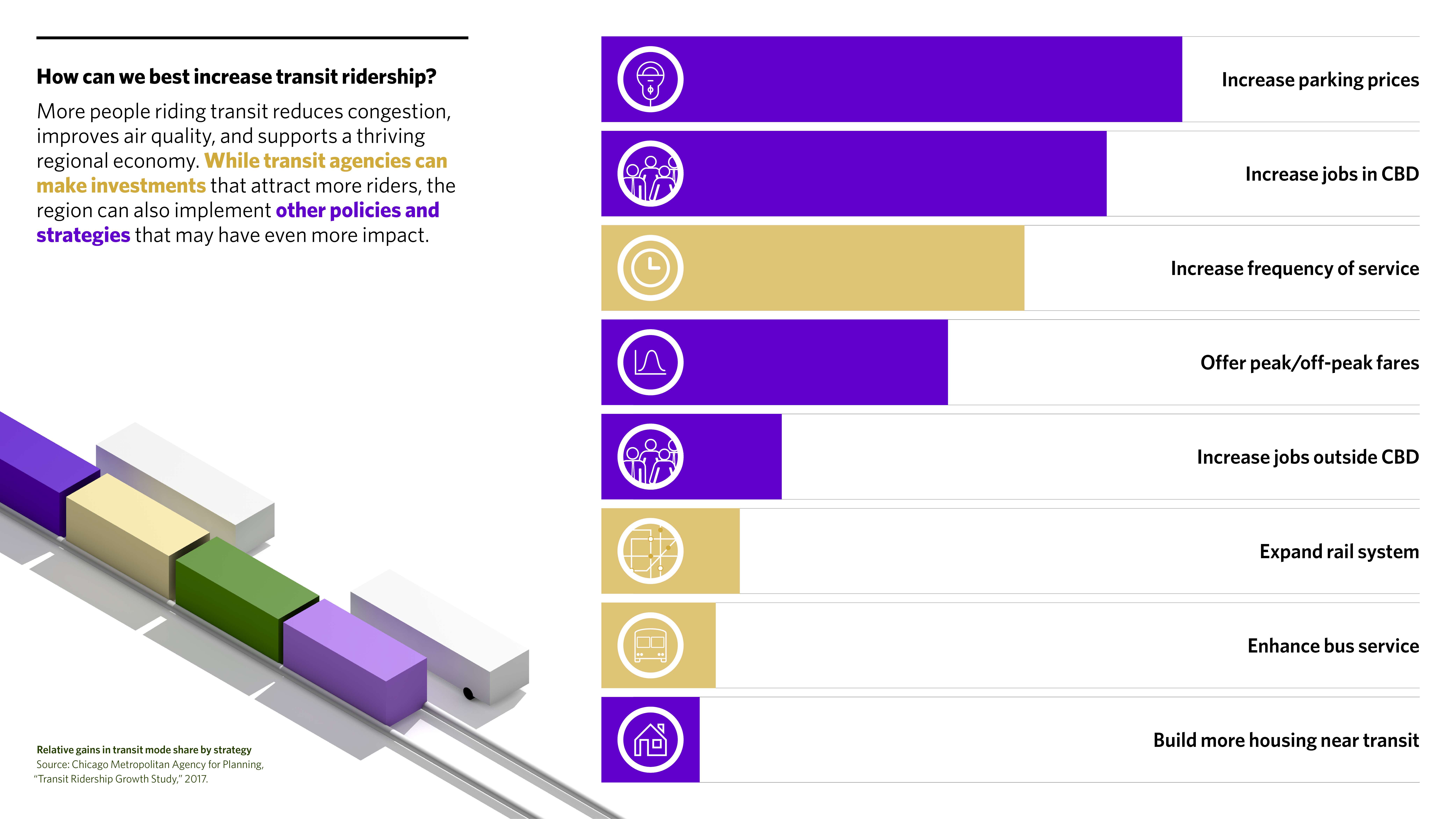Recommendation
Make transit more competitive

Our public transit system is one of metropolitan Chicago’s most critical assets, improving air quality, allowing travelers to avoid congested highways, and connecting people to jobs, education, entertainment, and other amenities. Public transit access is especially crucial for those who cannot drive or lack access to a car. In addition, a robust public transit network is an increasingly valuable asset that helps the region compete nationally for new businesses and residents. The region’s long-established public transit network is extensive: Together, the CTA, Metra, and Pace provide more than two million trips each weekday at a cost per rider that is among the nation's lowest. However, the system also faces numerous challenges, including lack of funding, minimal supportive land use changes, demographic shifts, aging infrastructure, and competition from emerging private transportation services.
In areas with rising transit use, growth is occurring at times and locations that strain local capacity. Ridership has boomed on CTA and Metra stations serving Chicago’s North Side and at the outermost stations of many Metra lines. Since 2000, weekend ridership has grown faster than weekdays on all modes of transit. Suburban areas with limited transit access, particularly in Cook County, have seen more population and employment growth than the rest of the region. Much of this growth is in demographic categories that tend to have higher rates of transit use, including groups that do not own cars or own only one car, low income residents, Asians, blacks, and younger adults. Older adults are growing in number: While less likely to ride transit than younger demographic groups, they nevertheless become more dependent on being driven to destinations as they age. ADA paratransit service in our region has grown dramatically in response to intensifying demand and likely will continue to grow as the population ages. Paratransit provides a critical mobility link for more than four million trips per year taken by people who cannot use a fixed-route service. However, paratransit can be 10 times more expensive to provide than fixed-route service, while statute limits fares to double those of fixed-route fares. This preserves affordability but may degrade the long-term sustainability of these services.
At the same time, population and employment have declined substantially along the southern branch of CTA’s Red and Green Lines as well as on the Metra Electric and Rock Island lines, triggering ridership declines. Bus ridership has also been in decline throughout the region and nation. Shifts in transit ridership create challenges for the public transit agencies, both in terms of providing sufficient capacity where demand is burgeoning and in allocating appropriate service levels to areas where ridership is declining, despite their residents' reliance on transit.
Strategies
The public transit agencies are experiencing a capital funding shortage, with mounting state-of-good-repair and modernization needs. While the transit agencies are committed to operating safely, 31 percent of the public transit system is not in a state of good repair -- a percentage projected to grow without significant increases in capital funding. Current funding levels often force the agencies to make difficult choices in the face of annual budget limitations, including to allow degradation of some assets’ condition. While the service boards have successfully and efficiently maintained basic service levels in this environment for some time, the transit system’s condition is degrading as the repair backlog grows, posing a long-term threat to service quality and reliability.
Public transit agencies are also facing increased competition for riders from emerging private sector mobility providers, particularly TNCs like Uber and Lyft that provide on-demand, door-to-door services at prices and speeds that make them attractive alternatives to public transit. The mobility innovations could make it easier for people to be less dependent on owning and driving their own cars and help solve the challenge of providing transportation options in less dense suburban areas that are currently difficult and expensive to serve with traditional public transit. Public transit agencies are already working to incorporate these technologies into their services. However, if left unchecked, private sector mobility services could also contribute to increased congestion, slower bus speeds, declines in transit ridership, and decreased service quality. Ensuring the continued success of the region’s mass transit network is in the best interest of private mobility providers, whose services are most widely used where people own fewer cars and rely on multimodal transportation options.
The prior comprehensive regional plan, GO TO 2040, set an aggressive goal of doubling transit ridership, and ON TO 2050 recommits to this goal. Because growth in transit ridership requires implementation by many stakeholders across many issues -- such as increasing funding for the transit system, intensifying development of housing and employment near bus and rail transit, and appropriately pricing roads and parking -- this indicator is a bellwether for the success of many ON TO 2050 recommendations. However, the region is not currently on track to achieve its transit ridership goal. Reaching it will require sustained investment in the transit system that substantively exceed today’s levels, and coordinated action by a wide range of stakeholders.
- Actual
- Target

To be competitive, transit must provide fast, frequent, reliable, and affordable service that connects people to important destinations. Surveys of the region’s riders and a growing body of transportation research show that the basics of transit service -- speed, frequency, reliability -- are the most important factors in promoting ridership and customer satisfaction. This finding offers clear focus for the limited dollars available to improve the region’s transit system. Investments that improve the speed and reliability of bus transit, such as dedicated lanes and TSP, are particularly cost-effective ways to improve transit service. On the rail system, addressing bottlenecks and capacity constraints on high ridership routes can improve reliability and allow more frequent service. ON TO 2050 sets targets for additional miles of roadway and number of traffic signals with transit priority.
To improve service and increase ridership requires regional action by not just the transit agencies, but also municipalities, highway agencies, and funding authorities. Transit agencies cannot sustain fast, frequent, reliable service without accompanying supportive land use changes. Effective transit service results from a combination of strategic investment in transit service and coordinated land use planning. Locating jobs and residences near transit has a powerful positive effect on ridership. CMAP analysis shows that taking steps to increase employment density near transit stations and pricing parking would have more impact on ridership compared to many other strategies for capital investment and service expansion.

The combination of historical development patterns and continued suburbanization of housing and employment in recent decades have created a mismatch between locations with high transit availability and those with high employment densities. As shown below, many suburban areas act as employment nodes but may have limited transit. Many neighborhoods with high concentrations of low income people of color have strong access to transit but may have few jobs nearby. This dynamic limits economic opportunity for people who depend on transit to get to work and must access jobs outside of the region’s core.

Places with high transit availability but low population and employment density can better support transit through targeted infill development. In some cases, these areas have experienced long-term job and population losses. (See the Invest in disinvested areas recommendation in the Community chapter for relevant strategies.) Places with high transit availability, high density, and transit oriented design and placement of buildings are good candidates for targeted investments to eliminate bottlenecks and improve the speed and reliability of bus transit. Employment centers with limited transit availability should be evaluated for potential additional services, especially services that connect these centers with economically disconnected communities, in concert with investment in walkable streets and development patterns.
Pedestrian accessibility is critical for an area’s ability to support high quality transit service. ON TO 2050 carries forward the GO TO 2040 recommendations to build walkable communities with a variety of services, amenities, and transportation options. ON TO 2050 sets a target of at least 45.2 percent of population and 41.9 percent of jobs located in areas with “high” or “very high” walkability by 2050. For more information about building walkable communities, see the Support development of compact, walkable communities recommendation in the Community chapter.
The following describes strategies and associated actions to implement this recommendation.
Diversify and increase transit funding sources
The region’s public transit system faces a $19 billion backlog simply to reach a state of good repair. If supported by diverse and sustainable sources of state, federal, and local funding, transit agencies would be empowered to improve the system’s state of good repair, modernize and enhance the system, support low income riders, and confidently move forward with high-priority projects. The need to increase revenue for the transportation system more broadly is central to the financial recommendations of ON TO 2050. Unless structured carefully, many revenue options under consideration have the potential to provide significantly more revenue for roads than transit. New revenues should provide substantive benefit for the public transit system and help the region achieve a well-integrated multimodal system. For example, automobile user fees should be used flexibly to improve the region’s transit, bicycle, and pedestrian infrastructure. See the Fully fund the region’s transportation system recommendation in the Mobility chapter for more information.
Invest in and protect transit’s core strengths
The region’s transit agencies should focus limited funding on projects that build on transit’s key strengths: frequent, fast, reliable service that makes connections in areas of moderate and high density and walkability. Transit can serve these markets and trips more efficiently and effectively than any other mode. The RTA has identified six key transit markets that enable the region to build upon existing transit assets, and these markets should be the focus of coordinated planning and investment by the transit agencies, IDOT, Tollway, CMAP, and local governments.
Focusing investment will mean different things for different transit modes. On the rail system, it often means addressing capacity constraints that limit the speed and frequency of trains on high ridership routes. These capacity constraints are often operational and relatively invisible to riders, such as lack of space at railyards and maintenance facilities, track junctions, and old signal systems. Bus service can be improved quickly and at relatively low cost; replacing traffic signals and implementing TSP are cost-effective investments that can substantially speed up service on arterial routes. In key corridors with high ridership or plans for supportive land use, the combination of TSP, dedicated right of way, and improved boarding strategies can substantially reduce travel times. The region should move forward on implementing planned ART routes and planning future bus system improvements.
Given transit’s importance as the backbone of a multimodal transportation system, it is also important to implement policies that help bolster transit’s core strengths and prevent degradation of public transit service on high frequency corridors through dense parts of the region. These policies could include new rules or regulations on private mobility services.
Move forward on implementing the highest performing planned Pace Pulse routes.
The region
Work together to implement a BRT network.
CTA and roadway agencies
Prioritize addressing capacity constraints on high ridership rail lines and planning for longer term capacity increases to better serve areas of high potential within the existing rail network.
CTA and Metra
Continue to work together to ensure the efficient operation of the region’s commuter rail system.
Metra and freight partners
Work with communities to establish policies for AVs, TNCs, and other emerging technologies that support and complement the public transit system.
CMAP, RTA, and the service boards
Ensure equitable transit access
Focusing only on the most productive elements of the transit system would likely leave many low income riders behind. Providing equitable, affordable, accessible service to most people -- particularly those who are low income, car-less, or with limited mobility -- has historically been integral to public transit’s mission. According to CMAP research, lower income people of color have longer-than-average commutes, and—despite typically living in areas with transit access—they often travel to jobs in places or at times with limited bus or rail service. These challenges are shaped in part by a spatial-mismatch in development driven by long term disinvestment in parts of the region frequently home to low income communities of color. As jobs have moved to less accessible areas, the commutes of these residents increasingly require transfers between multiple modes or service providers, costing more time and money. These residents may also be unable to afford up-front expenses for weekly or monthly passes that would save them money over the long run. Public transit agencies face difficult tradeoffs in ensuring efficient, reliable, affordable service while serving a diverse set of transit markets, particularly in an environment of declining revenue. The region must balance investments in growing areas where limited transit capacity isn't meeting increased demand versus areas where population has been declining but residents will continue to rely heavily on public transit. Reallocating scarce resources will require thoughtful, transparent, ongoing study. It is critical that these decisions include substantial community involvement and prioritize increasing affordable mobility options for low income residents, people with disabilities, and those without access to private vehicles.
All public transit agencies are required by Title VI of the Civil Rights Act to consider the impact of service and fare changes on minority populations and avoid disparate impacts based on race, color, or national origin. The region’s transit agencies are committed to delivering equitable and accessible transportation services. This includes making transit stations and vehicles more physically accessible to people with disabilities, as well as improving communications systems to make service navigable for those with visual and hearing impairments. All buses in the region are ADA accessible, although the immediate surroundings of many bus stops in the region are not. Likewise, all trains are accessible, but many train stations are not. The CTA is committed to making all rail stations accessible over the next 20 years as part of its All Stations Accessibility Program, but needs additional funding to achieve this goal. While many local governments have individual efforts, our region needs a coordinated effort to improve accessibility near all transit services. Policies to support equitable access must be complemented by strategies to promote coordination across public agencies, reinvestment in existing communities, and production of affordable housing near transit.
Continue to make progress toward universal accessibility of stations.
Transit agencies
Secure funding for completion of the All Stations Accessibility Program.
The region
Invest in accessible sidewalks and crossings that connect rail and bus stations to nearby destinations.
Transportation agencies
Continue to balance tradeoffs between achieving service efficiency and providing high quality service to lower income areas.
Transit agencies
Explore and pilot new fare strategies such as fare capping or low-income fares that reduce fare burden on lower income populations and social service providers.
Transit agencies
Plan for transit-supportive land uses
The region cannot meet its transit ridership goals without supportive development near bus and rail. Linking transit, housing, and land use was a focus of GO TO 2040 and continues to be an important part of ON TO 2050. Planning for the complex, interrelated nature of these issues can bring many quality of life and economic benefits to the region. Yet, as highlighted in the ON TO 2050 Infill and TOD snapshot report, such linkages are only being created sporadically, which limit the potential positive benefits to bus and rail transit ridership. As CMAP identified in the Transit Ridership Growth Study, the region is not on track to meet the transit use goals set in GO TO 2040. Placing housing near public transit is critical, but emerging research shows that placing employment near transit may have an even stronger impact on the success of transit. Planning for bus and rail transit-supportive land uses must also involve enhancing pedestrian and bike connections to transit, thereby making it easier and safer for employees and residents near transit corridors to walk or bike to rail or bus stations. Pace has established transit supportive guidelines focused on non-rail transit in suburban communities. This strategy also appears in the Community chapter under the recommendation to Support development of compact, walkable communities.
Update plans, zoning codes, and development regulations to require greater densities and mixed uses near rail stations and along high-priority bus corridors with a preference toward employment rich land uses.
Local governments
Require developers to consult with transit agencies to verify that proposed developments do not negatively affect existing or planned transit service.
Roadway agencies and municipalities
Prioritize capital projects that enhance pedestrian and bicycle access to rail and bus service.
Local governments
Strategically consider new transit investments, including bus and rail stops, which further the planning and development work of local governments.
Transit agencies
Offer additional consideration when allocating federal funding sources such as CMAQ, TAP, and STP for jurisdictions that actively plan for densities to support transit service.
CMAP and partners
Actively manage parking
The amount and location of parking influences the character, form, function and flow of our communities. Too much or poorly designed parking can make walking and bicycling unpleasant and unsafe, add to flooding and pollution problems, make housing more expensive, and reduce public transit use. At the same time, in some places, parking is necessary to support local businesses, support commuter rail stations with large market sheds, or to improve accessibility for people with disabilities. Planning for parking needs and pricing parking to manage demand can support businesses, raise local revenues, and help create compact, walkable communities. Configuring and designating parking appropriately can promote walkability and access for all users. All day parking for employees, commuters, or residents can compete with the short turnaround spaces needed for many retail, restaurants, and services. Communities may choose to reconfigure existing parking to meet these varying needs.
Recognizing the importance of parking management, CMAP developed a Parking Strategies to Support Livable Communities Toolkit that encourages communities to consider a wider array of solutions than just adding more parking. Valuable interventions include pricing on-street parking to manage demand in dense areas, reducing or eliminating minimum parking requirements, and setting maximum parking limitations in some locations. Through the LTA program, CMAP has also helped Berwyn, Hinsdale, and Wicker Park-Bucktown develop plans to identify and implement the right parking management practices for their neighborhoods. This strategy also appears in the Community chapter under the recommendation to Support development of compact, walkable communities.
Reduce or eliminate minimum parking requirements, or set maximum parking limitations in some locations, such as near transit.
Local governments
Price on-street parking to manage demand in dense areas.
Local governments
Monitor the implementation of active parking management approaches around the region to understand trends, approaches, and outcomes.
CMAP
Analyze current and future parking supply and demand at rail transit stations to evaluate the potential for alternative land uses and parking allotments to enable transit oriented development (TOD).
Local governments, CMAP, and Metra
Roadway agencies should prioritize improving transit service
Significant improvements to bus service can be achieved with relatively small capital expense, presenting the most cost-effective way to expand the region’s public transit system, and make the most efficient use of limited space on the region’s congested roadways. However, these improvements require the active engagement of roadway agencies, including IDOT, county transportation agencies, and municipal transportation departments. While these agencies are sometimes cautious to adopt transit oriented roadway improvements such as queue jumps, TSP, and dedicated transit space on roadways, such strategies have proven successful in other regions. Pilots and demonstration projects are critical for the region to educate roadway agencies about the opportunities for improving transit. Transit and highway agencies can also build on the success of Pace expressway service on I-55, I-94, and I-90 to offer additional routes and continue to provide innovative bus service options.
Place more emphasis on investments that improve public transit service, including TSP, queue jumps, and dedicated expressway and arterial right of way for transit vehicles.
Roadway agencies
Review and revise its design manuals and permitting processes to facilitate pedestrian, transit, and bicycle improvements wherever possible.
IDOT, working with municipalities and transit agencies
Involve transit agencies in early stages of project planning.
Roadway agencies
Include design treatments in expressway and arterial projects to better accommodate transit users and make service faster and more reliable.
Roadway agencies
Identify ways to leverage toll revenue to pursue multimodal transportation system goals such as providing high-speed, high-reliability transit service in expressway corridors.
IDOT and the Tollway
Make further progress in fare and service coordination
Fare coordination has improved in recent years through the Ventra system, which provides a platform for additional collaboration. With the ongoing expansion to Divvy and ADA paratransit, Ventra is taking an important step beyond core transit services. More work can and should be done to further technological and fare integration across agencies, while remaining accessible to the unbanked and others of limited means. There may also be opportunities for transit agencies to consider service adjustments and infill stations to improve connectivity between their services.
Leverage the capabilities of Ventra, continuing to provide and improve seamless payment for multiple transit providers and other modes such as bike sharing.
Transit agencies
Coordinate transfers, payment, and potentially fares between transit services and other modes of transportation.
Transit providers
Continue to review and revise overlapping service.
Transit agencies
Improve the effectiveness and accessibility of demand response services
Pace oversees several demand response programs, including paratransit service, which is available to eligible riders whose disability or health conditions prevent them from using fixed-route services; Dial-a-Ride, which is often but not always limited based on a person’s abilities, age, and/or income; Call-n-Ride, which is typically provided within a certain geography, such as a township or municipality; and Vanpool and rideshare programs that facilitate carpooling among people who have similar travel patterns and work hours. Counties, municipalities, townships, employers, healthcare providers, and developers also sometimes provide forms of demand response transportation for residents or clients. While ridership data is limited for these services, ADA paratransit use in our region has grown dramatically since 2000. Demand for all of these services is likely to continue to increase as the population ages. As the region’s population continues to age, improving demand response, along with transit service overall, will become increasingly critical.
Despite increasing use, this complex, overlapping network of services can be difficult for users to navigate and presents unique financial challenges for operators. Containing service areas within municipal, township, or county borders does not align with how people travel in a metropolitan area. Often, weekend, early-morning (before 9:00 a.m.), and evening (after 6:00 p.m.) services are minimal or nonexistent. Some services are limited to specific trip purposes or destinations and may not accommodate same-day travel requests. Many of these services are funded by local communities, and declining state and federal resources make these already expensive programs difficult to sustain.
New transportation technologies offer the increased ability to provide flexible, accessible on-demand options for trips that are difficult to serve by traditional fixed-route transit. The McHenry County Division of Transportation has taken a leadership role in recent years by leading the consolidation of various dial-a-ride services into a single service, called MCRide, which not only serves persons with limited mobility but also provides on-demand transportation in an area with limited fixed route transit services.
Identify new funding sources for demand response transit service to maintain and improve existing service, upgrade communications and scheduling technology, and expand eligibility, service hours, and geographic coverage.
The region
Work together to explore new ways to provide targeted, flexible and/or on-demand service in EDAs, low density areas, and for seniors and people with disabilities.
Transit providers, local governments, and the private sector
Continue to help coordinate and, as appropriate, consolidate demand response services within the region.
The RTA, Pace, and counties